|
Advantech SOM-5788
Intel Core i5/i7-powered COM-Express board provides superior performance and functionality for complex embedded systems projects
(by Conrad H. Blickenstorfer)
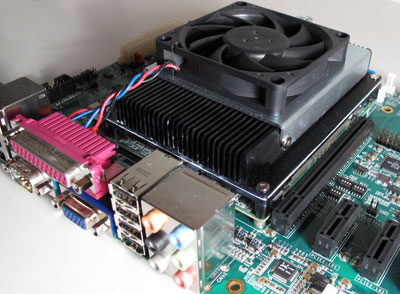 The Advantech SOM-5788 is a COM-Express module that can accommodate a variety of embedded standard voltage, low voltage, and ultra low voltage mobile Intel Core i5 and Core i7 processors. And that means it can simply do more than boards relying on older processor technology. The Intel GMA integrated in Intel "Arrandale" processors, for example, supports 18/24-bit LVDS, HDMI, Displayport, TV-out, and VGA. There's support for up to 8GB of 1066MHz DDR3 memory, as well as four PCI masters, 6 PCIex, 8 USB, four SATA-II, EIDE, 8-bit GPIO, advanced watchdog timer, and Advantech's iManager and software utilities and APIs. The Advantech SOM-5788 is a COM-Express module that can accommodate a variety of embedded standard voltage, low voltage, and ultra low voltage mobile Intel Core i5 and Core i7 processors. And that means it can simply do more than boards relying on older processor technology. The Intel GMA integrated in Intel "Arrandale" processors, for example, supports 18/24-bit LVDS, HDMI, Displayport, TV-out, and VGA. There's support for up to 8GB of 1066MHz DDR3 memory, as well as four PCI masters, 6 PCIex, 8 USB, four SATA-II, EIDE, 8-bit GPIO, advanced watchdog timer, and Advantech's iManager and software utilities and APIs.
What we have here is a highly integrated multimedia COM module that combines audio, video, and network functions with Intel Core i5/i7 processing power and technology advancements. This board can be used to infuse an entirely new level of performance into existing COM-Express solutions, or it can be used to create COM-Express projects providing previously unavailable levels of functionality and performance.
So what's COM-Express anyway?
COM stands for Computer On Module, and COM-Express, introduced in 2005 by the PICMG consortium, is a standard based on serial differential signaling technology for use in high performance embedded computing projects that require maximum I/O bandwidth, such as medical imaging, industrial automation, mapping, security, aerospace, etc.
COM-Express boards are often used for applications where PCI-X and AGP (Accelerated Graphics Port) are no longer powerful enough. They are small, too. Basic COM-Express modules measure just 4.92 x 3.74 inches (125 x 95mm), with an extended form factor measuring 6.1 x 4.3 inches (155 x 110 mm).
And when/why do you need it?
COM-Express modules such as the Advantech SOM-5788 are not meant to be stand-alone computers; instead, they provide the most complex part of any computer (the CPU board) and ancillary circuitry as an easily customizable module. This way, system integrators can select a COM-Express board as a basis for a complex emdedded systems project, saving time and money compared to starting from scratch.
The overall idea here is that the modules provide the basic computing power, but that all the customization and special functionality for a project takes place on an application-specific carrier board. COM-Express boards allow system integrators to concentrate on their applications rather than having to design an entire computer from scratch. Since they only include the CPU and some related circuitry, COM-Express boards are small and fit almost anywhere. They are also inherently more rugged than full-size boards.
Below you can see the top (left) and bottom (right) of the SOM-5788 board with its Intel Core i7-620LE processor and QM57 chipset. Note that the top picture doesn't show the required cooling sink and fan that covers the entire board.
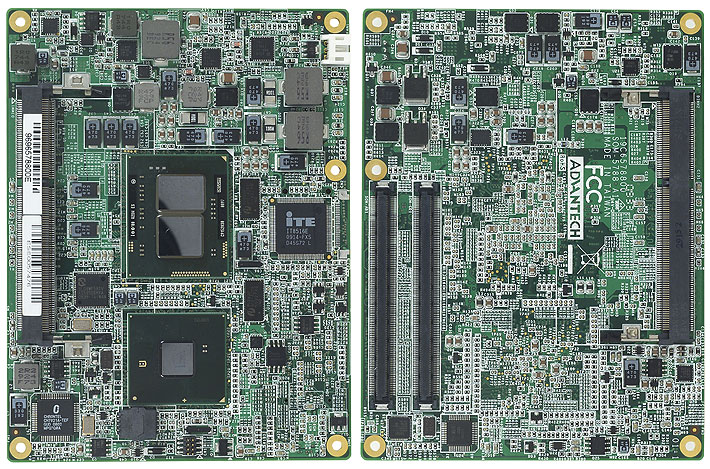
Like all standardized CPU boards, COM-Express boards connect to a carrier/solutions board (which usually looks like a motherboard) via standardized connectors. COM-Express uses two 220-pin edge connector, where one connector handles PCI, PCIe and IDE and the other connector everything else. RAM sits on the COM-Express module itself (there are two SODIMM slots on the SOM-5788), but all other expansion boards will sit on the carrier board.
The new Intel Core processors
The big deal about the Advantech SOM-5788 is its ability to use some of Intel's latest embedded Core processors. What's special about that? A lot. As a first in this class of Intel CPUs, the memory controller and fairly powerful integrated graphics with HD hardware acceleration are part of the processor, eliminating the need for a conventional Front Side Bus and thus the "Northbridge" part of the chipset. These processors are capable of driving multi monitors in any combination of Display Port, HDMI, DVI and VGA, and even offer dual simultaneous HDMI support. Arrandale supports two audio streams instead of just one and adds Dolby TrueHD and DTS-HD audio support.
What's the difference between Core i3, i5 and i7 processors? By and large, they represent Intel's "good," "better," and "best" processor solutions in any given category. Core i3 processors (not offered for the SOM-5788), for example, do not have the clever Intel TurboBoost feature that provides extra performance via automatic overclocking. Core i7 processors generally have more cache and support more special Intel features than Core i5 and Core i3 processors. There is actually a good degree of overlap both in functionality and performance, and specific project requirements will drive processor selection.
High Performance
Testing a CPU module is a bit trickier than testing a full mobile product (you just turn it on) or even a conventional motherboard (you connect a display, disk and keyboard). Fortunately, Advantech sent us one of their standard SOM-DB5700 development boards. The SOM-DB5700 looks very much like your average desktop motherboard with all the usual connectors and battery of ports. However, the DB5700 also has connectors to accommodate a COM-Express board as it does not have its own CPU and chipset.
We used a donor desktop machine to supply ATX power, an LCD display, and a hard disk with Windows XP on it. It took a bit of BIOS configuring to start the SOM-5788 with our comparatively ancient IDE hard disk, and once it was running Windows played its usual tricks, like demanding new software activation because the disk now used new hardware, and being absolutely clueless about any drivers (why, oh why, can Windows not at least figure out the basics without needing a CD-ROM or going on the internet??). After some wrestling with Redmond's finest, we had a working system, albeit one sans most drivers, so running a full benchmark suite was out of the question.
We did, however, run part of one of our standard benchmark suites, CrystalMark, exercising the CPU and memory in the process. Here are the results compared to some other Advantech products we've tested:
PERFORMANCE COMPARISON
CRYSTALMARK 2004R3
|
Core i7-620LE
|
Core 2 Duo T7400
|
Core Duo L2400
|
Atom N270
|
Atom Z530
|
|
Clock speed
|
2.0GHz
|
2.16GHz
|
1.66GHz
|
1.6GHz
|
1.6GHz
|
|
Tested in Advantech:
|
SOM-5788
|
PPC-157T
|
ARK-3399
|
SOM-5761
|
SOM-6760
|
|
ALU
|
31419
|
19311
|
12971
|
5413
|
5376
|
|
FPU
|
35007
|
22560
|
15353
|
4726
|
4667
|
|
MEM
|
23251
|
10867
|
6407
|
4172
|
3667
|
The results speak for themselves. In terms of raw performance, the Core i7-620LE processor in the SOM-5788 board runs rings around the Core 2 Duo and Core Duo processors, let alone the Atom chips. That's impressive considering that the i7-620LE is only a low voltage chip with a modest 25 watt TDP; the also available standard voltage i7-620E, clocking at 2.53GHz and having a turbo-boost max speed of 3.2GHz, would be that much faster yet. This board is all about performance.
Below is a schematic of the Advantech SOM-5788:
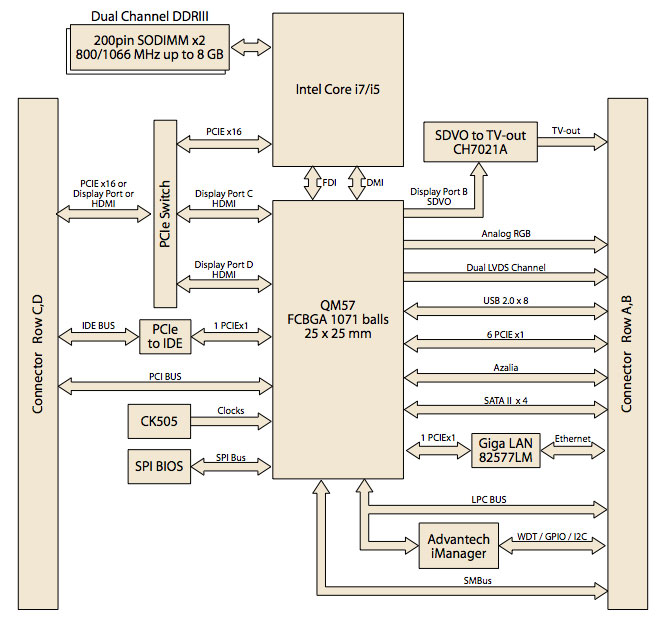
Computer modules like the Advantech SOM-5788 populate an entirely different market specturm from what we usually see here at RuggedPCReview.com. Each of the various module standards has its pros and cons, and allows system integrators and designers to build customized embedded solutions.
Come to think of it, a good many rugged mobile systems and rugged PCs have been perfected for their jobs and do not need exterior or functional redesign, but they suffer from dated electronics because the relatively low sales volumes makes full redesign too expensive. Now if they could simply replace the CPU module to bring performance back up to current standards ....
Advantech SOM-5788 Specs:
| Type |
COM-Express Module
|
| CPU Type |
Intel Core i7-620LE (also available: Core i5-520E, Core i7-620UE, Core i7-610E)
|
| Clock Speed |
2.00GHz
|
| Chipset |
Intel QM57
|
| BIOS |
AMI 64 Mbit Flash BIOS
|
| Memory |
Max 8GB DDR3 800/1066MHz in 2 200-pin SODIMM sockets
|
| Graphics Controller |
Intel GMA integrated in Core i5 or Core i7 |
| VRAM |
unknown
|
| LVDS |
Dual channel 18/24-bit LVDS; VGA 2048 x 1536 pixel; Displayport 2560 x 1600 pixel; HDMI/DVI 1920 x 1200 pixel; TV-out (though SDVO)
|
| Dual display |
Up to 4 independent displays
|
| LAN |
2 x 10/100/1000Base-T Intel 82577LM) |
| SATA |
4 x 300 MB/s SATA II |
| EIDE |
1 x UDAM 100
|
| SSD |
via CF Card
|
| USB |
8 x USB 2.0
|
| Serial |
NA |
| Parallel |
NA |
| Audio |
HD audio |
| DIO |
8-bit GPIO |
| Watchdog Timer |
65536 level timer interval, from 0~65535 sec, multi-level, multi-option watchdog timer
|
| Size |
95 mm x 125 mm (3.75" x 4.92")
|
| Weight |
3.8 oz. (board and memory); 18.7 ounces (board with with fan and heat sink) |
| Operating Temp. |
32 to 140F
|
| Price |
inquire
|
| Datasheet |
Advantech SOM-5788 |
Advantech Corporation
38 Tesla, Suite 100
Irvine, CA 92618
Toll Free: 1-800-866-6008
Ph: 949-789-7178
Fax: 949-789-7179
ECGInfo@advantech.com
www.advantech.com
Advantech Co. Ltd.
No.1, Alley 20, Lane 26, Rueiguang Road
Neihu District, Taipei Taiwan 114, R.O.C.
Tel: 886-2-2792-7818
Fax: 886-2-2794-7301
www.advantech.com
|



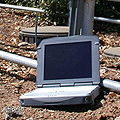

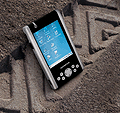
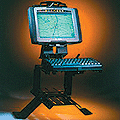





 The
The 
